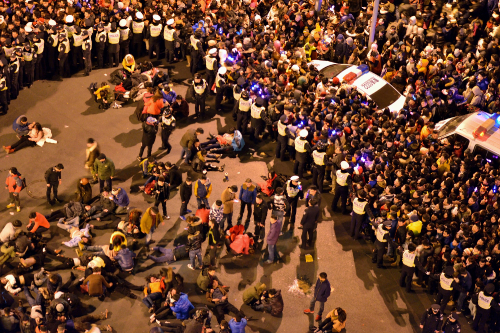|
 |
|
AFTERMATH: Volunteers offer aid to the injured as the Shanghai police perform crowd control at the Bund in Shanghai after the stampede on December 31, 2014 (CFP) |
Premier Li Keqiang underscored the importance of safety in public places, particularly during holidays.
Li told local authorities to "make every effort" to reduce injury-related deaths and console relatives, adding that strict precautions should be taken against major incidents, and public safety and social stability should be ensured.
The municipal government of Shanghai set up a working team for rescue operations and to deal with the aftermath. "The lesson was extremely profound and painful," said Shanghai Mayor Yang Xiong on January 6 at a session of the standing committee of the city's legislature, the Shanghai Municipal People's Congress. "The consequences of the accident are very grave."
Some survivors said the stampede was triggered when some people started to throw coupons resembling U.S. banknotes to revelers outside a bar on the windy night.
Events unfold
Witness Wu Tao said some coupons were being thrown from a building's third-floor window near the Bund, which some people standing along the river bank started scrambling to grab.
The coupons had "M18" printed in the center, believed to refer to a bar bearing the same name on the Bund.
The official microblog of the Shanghai police said on January 1 that the coupons were dropped at about 11:47 p.m., after the stampede happened, according to surveillance video.
This was not the first stampede that happened in China. In 2004, a stampede on a local bridge in suburban Beijing killed 37 during a lantern festival. In January 2014, a mosque stampede killed 14 people and injured another 10 in northwest China's Ningxia Hui Autonomous Region. In September 2014, six students were killed in a stampede at a primary school in Yunnan Province after a stairway was blocked.
"When an influx of tourists exceeds the limit--one person per square meter indoors and four people for every three square meters outdoors--the authorities should temporarily shut down the area and evacuate the people," said Liu Shilin, head of the academy of urban science with the Shanghai Jiao Tong University. "Information technology can be used to detect the population density and make timely warnings through social media platforms, such as microblogging."
"For mega-cities like Shanghai, the government should set up a permanent safety management department to coordinate operations of all safety-concerned departments and ensure safety measures are put in place," said Teng Wuxiao, Director of the Public Safety Research Center with Fudan University.
"The Bund's viewing platform is long and narrow and the structure of the Chen Yi Square staircase makes it hard for crowds to flow. The disorder at the scene also exposed the deficiency in emergency exercise and safety education."
Wu Xiaoxiao, a nurse from Wenzhou Children's Hospital in the neighboring Zhejiang Province, was at the scene when the tragedy happened. "We intended to climb up to the platform but gave up right before the stampede occurred," said Wu.
The police then cleared a space at the square to lay down the injured. Wu, after identifying herself as a nurse, was allowed in to offer emergency help.
"There were few people that had the professional knowledge of emergency medical care," said Wu. "Most of the relatives and friends could do nothing but desperately shout for help."
"For high-risk areas, the authorities should have special emergency response plans and perform sufficient analysis and assessment, including the arrangement of police, volunteers and supporting measures," said Teng.
| 